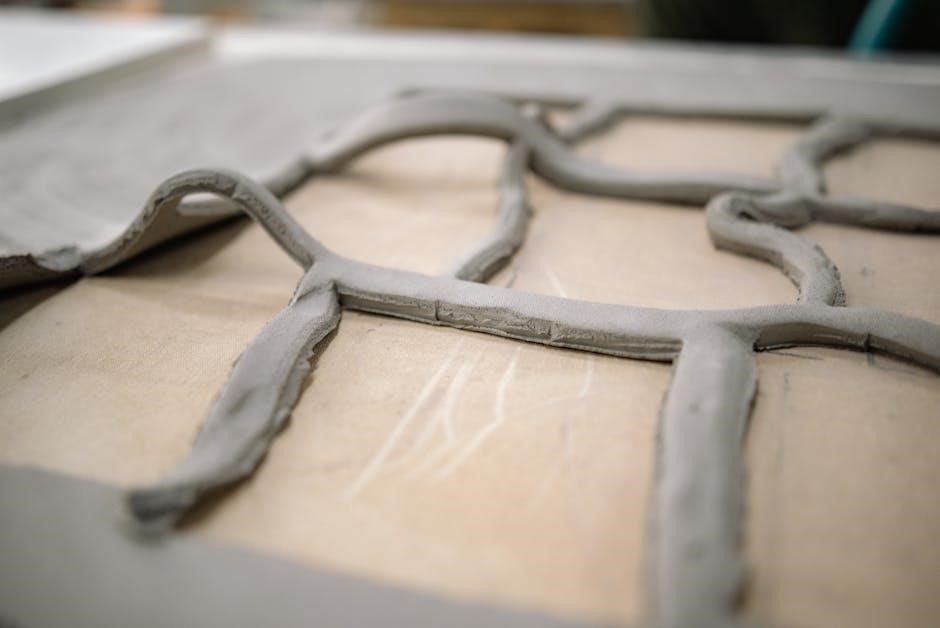Explore our collection of free printable 2D and 3D shape worksheets, designed to help children recognize, name, and understand geometric figures through engaging activities, suitable for preschool to higher grades.

Understanding 2D and 3D Shapes
2D shapes are flat, having height and width, while 3D shapes are solid, with length, width, and height, such as cubes and spheres.
Definition and Examples of 2D Shapes
2D shapes are flat, having only height and width, with no depth. Common examples include circles, squares, triangles, rectangles, and ovals. These shapes are fundamental for early education, helping children develop spatial awareness and problem-solving skills. Worksheets often feature activities like tracing, drawing, and identifying these shapes, making learning interactive and fun. Recognizing 2D shapes is essential for understanding geometry and real-world applications, such as identifying shapes in nature or everyday objects. By practicing with worksheets, kids build a strong foundation for more complex concepts later in their academic journey.
Definition and Examples of 3D Shapes
3D shapes, or three-dimensional shapes, have length, width, and depth, making them solid objects. Common examples include cubes, spheres, cylinders, cones, and pyramids. These shapes are essential for understanding real-world objects and spatial relationships. Worksheets often feature activities that help children identify and name 3D shapes, such as matching games or sorting exercises. Recognizing 3D shapes enhances problem-solving skills and prepares students for advanced geometry. By practicing with worksheets, kids gain a deeper understanding of how these shapes exist in their everyday environment, from toys to household items, fostering a strong foundation for future academic success.

Benefits of Using Worksheets for Learning Shapes
Worksheets enhance cognitive skills, build academic foundations, and boost engagement, offering structured activities that make learning shapes fun and effective for children of all ages and skill levels.
Cognitive Development Through Shape Recognition
Shape recognition is a cornerstone of early cognitive development, enhancing spatial awareness and problem-solving skills. Worksheets designed for 2D and 3D shapes help children identify and differentiate between various geometric figures, fostering visual perception and memory. By engaging with these activities, kids develop the ability to recognize shapes in different orientations and sizes, laying the groundwork for advanced mathematical concepts. Interactive exercises, such as tracing and matching, make learning enjoyable while strengthening critical thinking. These skills are essential for understanding real-world objects and their properties, preparing children for more complex challenges in geometry and beyond. Fun and structured, shape worksheets make cognitive growth both effective and engaging.
Building a Strong Academic Foundation
Mastering 2D and 3D shapes through worksheets establishes a robust academic foundation, equipping children with essential skills in geometry and spatial reasoning. These exercises introduce fundamental concepts like shape recognition, properties, and differences, preparing students for advanced math. Worksheets cater to various learning styles, offering activities such as tracing, drawing, and identifying shapes, which reinforce memory and understanding. By practicing with these resources, children develop problem-solving abilities and visual perception, crucial for future academic success. The structured format of worksheets ensures consistent learning, making complex concepts accessible and engaging. This strong foundation supports lifelong learning in mathematics and real-world applications, fostering confidence and academic readiness.
Enhancing Engagement and Interactive Learning
Interactive 2D and 3D shape worksheets captivate young learners by transforming geometry into a dynamic experience. Activities like tracing, drawing, and identifying shapes keep children engaged, fostering a deeper connection with the material. Vibrant visuals, playful designs, and creative exercises make learning enjoyable, while hands-on tasks encourage active participation. These worksheets cater to diverse learning styles, ensuring every child can thrive. By incorporating fun elements, they motivate students to explore and understand geometric concepts with enthusiasm. This interactive approach not only enhances focus but also builds confidence, making complex ideas feel accessible and exciting. Engaging worksheets create a lively learning environment that sparks curiosity and love for geometry.

Activities in 2D and 3D Shapes Worksheets
Engage your child with tracing, drawing, identifying, and comparing 2D and 3D shapes, fostering hands-on learning and a deeper understanding of geometric concepts through interactive exercises.
Tracing and Drawing Shapes
Tracing and drawing activities in 2D and 3D shape worksheets help children develop fine motor skills and hand-eye coordination while introducing them to basic geometric figures. These exercises allow kids to practice tracing outlines of circles, squares, triangles, and more, gradually improving their ability to draw shapes independently. For 3D shapes, worksheets often include templates for tracing cubes, spheres, and pyramids, helping children visualize how 2D shapes transform into 3D objects. Drawing activities also encourage creativity, as children can color and label shapes, reinforcing their understanding of properties like sides, angles, and dimensions. Free PDF resources provide ample opportunities for repetitive practice, making learning fun and engaging for young learners. These exercises lay a strong foundation for geometry and spatial awareness, essential for future academic success.
Identifying and Naming Shapes
Identifying and naming shapes is a fundamental skill that 2D and 3D shape worksheets help children master. These exercises often feature sets of shapes, both familiar and complex, for kids to label and recognize. Activities include matching games, where children link shapes to their names, and multiple-choice questions to test their understanding. Worksheets also encourage kids to identify shapes in various orientations, reinforcing the concept that shapes remain consistent regardless of rotation or size. This skill-building process enhances memory retention and spatial awareness, providing a strong foundation for geometry. Free PDF resources offer diverse exercises, ensuring children can practice identifying squares, circles, triangles, cubes, and more, making learning interactive and enjoyable for all age groups.
Comparing 2D and 3D Shapes
Comparing 2D and 3D shapes helps students understand the differences between flat and solid figures. Worksheets often include activities where children classify shapes as 2D or 3D, enhancing their spatial reasoning. These exercises encourage kids to recognize that 2D shapes, like circles and squares, lack depth, while 3D shapes, such as cubes and spheres, have height, width, and depth. By analyzing and categorizing shapes, students develop a clearer grasp of geometric concepts. Such comparisons also improve visual processing skills, as children learn to identify shapes in various orientations and contexts. These activities are ideal for early learners, providing a hands-on approach to differentiate between plane and solid figures effectively.
Calculating Properties of Shapes
Worksheets for calculating properties of shapes help students practice measuring and computing attributes like area, perimeter, and volume. For 2D shapes, activities include finding the area of circles, squares, and rectangles, while 3D shapes focus on calculating surface area and volume of cubes and spheres. These exercises enhance mathematical skills and problem-solving abilities. Students learn to apply formulas and use measurement tools effectively. Such tasks build a strong foundation in geometry and prepare learners for advanced math concepts. Interactive and visually appealing worksheets make these calculations engaging, ensuring students enjoy the learning process while mastering essential skills. Regular practice fosters confidence and accuracy in handling geometric properties.

Downloading and Accessing Worksheets
Access a wide range of free, printable 2D and 3D shape worksheets in PDF format, easily downloadable from trusted educational websites like Kiddo Worksheets for convenient learning.
Free Resources for 2D and 3D Shapes
Discover a variety of free, downloadable 2D and 3D shape worksheets in PDF format, designed for kids of all ages. These resources include tracing, drawing, and identifying activities, helping children learn and recognize shapes. Suitable for preschool to higher grades, they offer engaging exercises to enhance spatial awareness and geometry skills. Parents and educators can access these worksheets effortlessly, providing a cost-effective way to support learning. With vibrant visuals and interactive tasks, these free resources make shape recognition fun and effective, ensuring a strong foundation in geometry for young learners.
How to Find High-Quality Worksheets
To find high-quality 2D and 3D shape worksheets, explore reputable websites like KiddoWorksheets.com, which offers free, engaging, and error-free resources. Look for worksheets designed by professional educators, ensuring they align with your child’s age and skill level. Check for vibrant visuals, clear instructions, and interactive activities to keep kids engaged. Many sites provide customizable options, allowing you to tailor worksheets to specific needs. Additionally, utilize worksheet generators to create unique exercises, ensuring variety and relevance. Prioritize resources that balance fun with educational value, helping children build a strong foundation in geometry and spatial awareness.

Using Worksheets Effectively
Engage students with interactive 2D and 3D shape worksheets, utilizing worksheet generators for customization. Focus on hands-on activities and clear visuals to enhance learning and retention effectively.
Strategies for Parents and Educators
Parents and educators can maximize learning by incorporating interactive 2D and 3D shape worksheets into daily routines. Start with tracing activities to build fine motor skills and shape recognition. Use flashcards for quick identification drills, and encourage sorting games to differentiate between 2D and 3D shapes. Integrate real-world examples, such as identifying shapes in household objects, to deepen understanding. For older students, introduce calculations like perimeter and area. Utilize worksheet generators to customize content for individual needs. Track progress and celebrate milestones to keep children motivated. By combining hands-on practice with engaging visuals, parents and educators can create a fun and effective learning environment for mastering shapes.

Integrating Worksheets into Lesson Plans
Integrating 2D and 3D shape worksheets into lesson plans enhances engagement and reinforces geometric concepts. Start by aligning worksheets with curriculum goals, ensuring activities match the skill level of your students. Incorporate interactive elements, such as tracing, sorting, and identifying shapes, to make learning dynamic. Use real-world examples to connect shapes to everyday objects, fostering practical understanding. For older students, integrate calculations like perimeter and area to build advanced skills. Utilize worksheet generators to create customized exercises tailored to specific lesson objectives. Regularly review and adapt worksheets to track progress and maintain student interest. This structured approach ensures a seamless integration of worksheets into your teaching strategy, promoting effective and enjoyable learning experiences.

Importance of Learning Shapes in Early Education
Learning shapes in early education builds foundational skills, enhancing spatial awareness and problem-solving abilities. It helps children recognize and identify shapes in real-world objects, fostering creativity and logical thinking.

Role in Developing Spatial Awareness
Learning 2D and 3D shapes plays a crucial role in developing spatial awareness, a skill essential for understanding how objects relate in space. Worksheets featuring shape recognition and comparison activities help children visualize and navigate their environment. By identifying and matching shapes, kids improve their ability to recognize patterns and relationships between objects. Activities like tracing, drawing, and sorting shapes enhance problem-solving skills and hand-eye coordination. These exercises also encourage children to think critically about how shapes fit together, fostering a deeper understanding of spatial concepts. This foundational skill is vital for future math and science learning, making shape worksheets a valuable educational tool.
Connection to Real-World Applications
Recognizing and understanding 2D and 3D shapes is essential for connecting mathematical concepts to real-world scenarios. Shapes are fundamental in architecture, engineering, and design, where buildings, bridges, and products rely on geometric forms. For instance, circles are used in wheels, squares in construction materials, and spheres in globes. Even everyday objects like household items and toys are designed using basic shapes. By mastering shape recognition, children gain a deeper appreciation for how these forms function in practical applications. This connection helps bridge the gap between abstract learning and tangible, real-world uses, making geometry relevant and meaningful in their daily lives.
Advanced Topics in Shapes for Older Students
Explore complex 2D and 3D shapes, their properties, and applications in geometry. These advanced worksheets introduce symmetry, tessellation, and real-world problem-solving, preparing students for higher-level math concepts.
Exploring Complex 2D and 3D Shapes
Delve into intricate 2D shapes like hexagons, octagons, and pentagons, and complex 3D shapes such as pyramids and prisms. These advanced worksheets introduce properties like symmetry, vertices, and angles, helping older students build on foundational shape knowledge. Activities include tracing, drawing, and identifying complex shapes, fostering deeper understanding. Real-world applications, such as architecture and engineering, are highlighted to connect learning to practical scenarios. Problem-solving exercises encourage critical thinking and prepare students for advanced geometry concepts. These resources are designed to challenge and engage, ensuring a smooth transition to higher-level math.
Applying Shape Knowledge in Geometry
Mastering 2D and 3D shapes is essential for advancing in geometry. Worksheets designed for older students focus on applying shape knowledge to solve real-world problems. Activities include calculating areas, volumes, and surface areas, as well as identifying shapes in composite figures. Students learn to use properties like symmetry, angles, and vertices to classify and analyze shapes. These exercises bridge the gap between basic recognition and complex geometric concepts, preparing learners for advanced topics. By applying shape knowledge, students develop problem-solving skills and spatial reasoning, crucial for subjects like architecture, engineering, and design. These worksheets ensure a smooth transition to higher-level math by building on foundational skills.
Customizing Worksheets for Individual Needs
Utilize worksheet generators to create tailored exercises, adapting content for different age groups and learning levels. Customize visuals, complexity, and activities to meet specific educational goals and student preferences.
Using Worksheet Generators
Worksheet generators offer a flexible way to create customized exercises for learning 2D and 3D shapes. Tools like the Kiddo Worksheet Generator allow educators and parents to design activities tailored to specific age groups or skill levels. Users can select shape types, difficulty levels, and even visual styles to enhance engagement. These generators save time by automating the creation process, ensuring high-quality, error-free content. They also enable the integration of vibrant colors, fun characters, and interactive elements to make learning more appealing for children. With such tools, educators can effortlessly produce worksheets that align with curriculum goals, catering to diverse learning needs and preferences. This versatility makes worksheet generators an invaluable resource for effective shape education.
Adapting Worksheets for Different Age Groups
Worksheets for 2D and 3D shapes can be tailored to suit various age groups, ensuring age-appropriate learning. For preschoolers, activities focus on tracing, naming, and identifying basic shapes like circles and squares. Kindergarten and Grade 1 students engage in sorting 2D and 3D shapes, enhancing spatial awareness. Older students in Grades 2-4 explore complex shapes, calculate properties, and compare dimensions. Worksheets for higher grades introduce advanced geometry concepts, applying shape knowledge to real-world problems. Adapting content ensures a smooth progression, building a strong foundation and keeping children engaged. Free PDF resources and generators allow customization, making learning accessible and enjoyable for all age groups.

Conclusion
In conclusion, 2D and 3D shapes worksheets are invaluable tools for fostering geometric understanding in children. They provide engaging, interactive, and age-appropriate activities that cater to diverse learning needs. From tracing and identifying shapes to comparing dimensions and calculating properties, these resources offer a comprehensive approach to spatial awareness and cognitive development. With free, high-quality PDF downloads available, parents and educators can easily access materials that align with curriculum goals. The adaptability of these worksheets ensures they remain relevant for children of all ages, making learning fun and effective. By leveraging these resources, kids can build a strong foundation in geometry while enjoying the process of discovery and growth.



